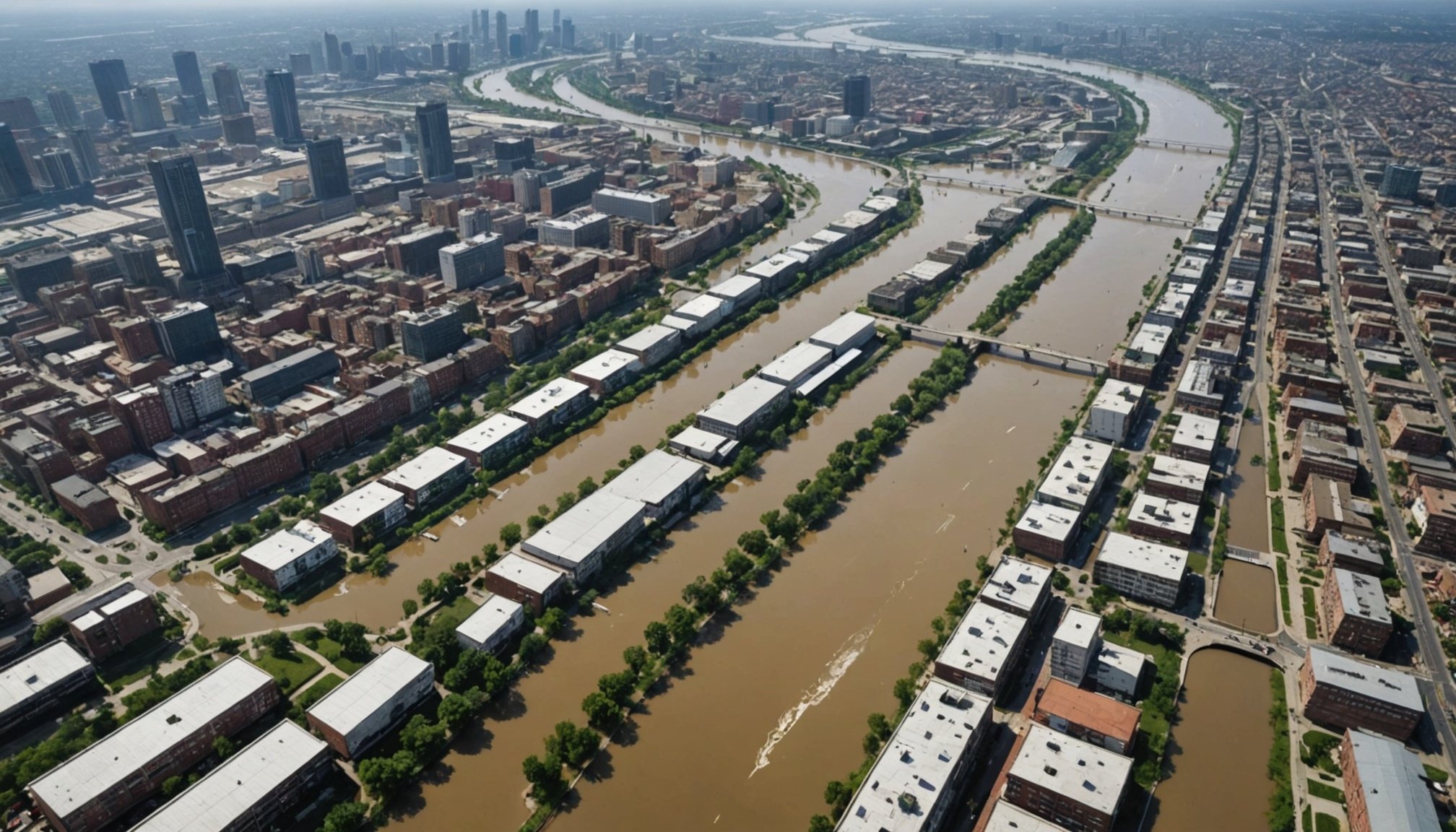Case Studies of Successful Urban Flood Mitigation
Understanding successful urban flood mitigation examples is crucial for cities worldwide aiming to enhance resilience against climate-induced challenges. Each city’s approach provides a unique perspective on effective measures.
New York City’s Big U Project
The Big U Project is an ambitious initiative designed to shield Lower Manhattan from future floods. It encompasses an integrated system of parks, floodwalls, and berms, each tailored to complement the existing urban landscape. The project succeeded in enhancing the area’s flood defences while also creating recreational spaces for residents. Key lessons from this project stress the need for community involvement and the integration of multiple benefits, such as leisure and environmental improvements.
In the same genre : Effective strategies for boosting the promotion of new condominium developments
Amsterdam’s Water Management Strategy
Known for its expertise in water management, Amsterdam employs innovative infrastructure strategies, intertwining flood management with urban development. The city’s approach includes adaptive measures, like elevating streets and constructing floating houses, demonstrating flexibility in integrating flood resilience without disrupting urban growth. These methods underline the crucial balance between infrastructure and development.
Singapore’s Integrated Drainage Management
Singapore’s holistic strategy involves cutting-edge technology and effective community engagement. By implementing smart drainage systems and fostering community-level awareness, Singapore has improved flood management outcomes significantly. This case exemplifies the power of combining advanced technologies with active community participation to create robust flood mitigation solutions.
Also to discover : Revitalizing victorian residences: cutting-edge eco-friendly renovation techniques for sustainable makeovers
Introduction to Sustainable Urban Flood Management
Sustainable urban flood management serves as a cornerstone for contemporary city planning. With climate change drastically altering flooding patterns, cities face the challenge of adapting rapidly. Urban areas are especially vulnerable due to their density and infrastructure. As rainfall intensifies and sea levels rise, the risk of devastating floods increases significantly. Therefore, incorporating sustainable solutions into urban planning is more crucial than ever.
These sustainable practices aim to mitigate the impacts of floods while promoting environmental health and community resilience. By integrating green infrastructure and innovative technologies, cities can reduce their flood risk and enhance urban ecosystems. Green solutions, like permeable pavements and rain gardens, help absorb excess water, decreasing the likelihood of floods. They also improve urban biodiversity and air quality, offering a dual benefit.
Furthermore, sustainable urban flood management considers social aspects. It engages communities actively in planning and decision-making processes. This involvement ensures that developed solutions are tailored to local needs and conditions. It also fosters community resilience, as residents become more informed and prepared to respond to flood events.
Ultimately, these measures pave the way for cities to thrive despite the challenges posed by a changing climate.
Innovative Technologies for Flood Management
Advancements in cutting-edge flood management technologies are transforming urban planning. Smart water management systems, integrating Internet of Things (IoT) solutions, are pivotal in predicting and mitigating flood impacts. These systems utilise sensors and real-time data to monitor water levels and weather conditions, providing immediate alerts to authorities and residents. This proactive approach enhances response times and minimises damage.
The application of Geographic Information Systems (GIS) for flood risk assessment offers detailed insight into vulnerable areas. By mapping historical data and simulating flood scenarios, GIS aids in planning and resource allocation, ensuring that high-risk zones are prioritised in flood defence strategies.
Incorporating green infrastructure solutions like permeable pavements and rain gardens contributes to sustainable urban planning. Permeable pavements allow rainwater to seep through surface layers and into the ground below, reducing runoff and flood risk. Rain gardens, strategically placed, absorb excess rainfall, helping manage stormwater naturally while enhancing urban aesthetics.
Together, these innovations create a comprehensive network of preventative measures. By leveraging technology and nature-based solutions, cities can achieve robust flood resilience. Investing in these advanced systems not only protects urban infrastructure but also fosters community safety and ecological balance.
Benefits of Sustainable Practices in Flood Management
Sustainable flood management practices have far-reaching benefits, crucial for modern urban planning. One of the foremost advantages lies in the economic benefits. By investing in sustainable solutions, cities can significantly reduce the costs associated with flood damages, rehabilitation, and maintenance. Implementing these systems may require upfront investment, but their long-term savings are indispensable.
Moreover, sustainable approaches contribute to the enhancement of urban biodiversity. By integrating green infrastructure like rain gardens and permeable pavements, urban areas can boost local flora and fauna. These green spaces not only offer ecological benefits but also improve air quality and community well-being.
Communities that adopt sustainable flood management gain enhanced resilience against climate-related disasters. Educating residents and involving them in the planning process fosters a proactive approach to flood management. This empowers communities, making them more responsive and adaptable during extreme weather events.
The SMART implementation of these solutions underlines their versatility, serving dual purposes of environmental protection and urban development. As cities aim for sustainability, these practices offer a clear pathway to align economic benefits with ecological and social goals. They bolster infrastructure resilience whilst providing a blueprint for future urban planning.
Expert Insights on Future Directions in Urban Flood Management
Understanding future flood management strategies is pivotal as urban planners brace for increasing climate challenges. Experts underscore the necessity of multi-layered approaches that combine technology with ecological awareness to advance urban planning.
Key insights emphasize the adoption of advanced drainage systems. Climate-resilient designs, integrated with IoT and sensors, provide real-time data and insights, fostering proactive response capabilities. Experts advocate for cities to prioritize continuous innovation in technology and methodology.
A noticeable trend lies in leveraging community involvement. Planners highlight the importance of engaging residents actively, informing them about flood risks and necessary precautions. This involvement not only aids in tailored solution development but also enhances community readiness and adaptability.
Incorporating sustainable solutions into urban policies emerges as crucial. Encouraging the use of green infrastructure, such as rain gardens and permeable surfaces, offers dual benefits of water management and biodiversity improvement. Urban policy experts suggest frameworks that incentivise such eco-friendly adaptations.
Conversations with specialists reveal a consensus: strengthening urban flood resilience is an ever-evolving challenge. By combining technology, community efforts, and innovative policies, cities can aim to reduce the impacts of future climate-induced floods significantly. This forward-thinking approach ensures sustainable prosperity amidst environmental unpredictability.
Actionable Guidelines for Implementing Flood Management Solutions
In advancing sustainable urban flood management, clear guidelines are vital for effective implementation. Understanding the complex interplay of urban dynamics and environmental forces lays the groundwork for impactful flood management.
Planning Stage Considerations
The initial phase demands thorough stakeholder engagement. This ensures diverse perspectives inform planning decisions, tailoring strategies to community needs and environmental contexts. Key factors include assessing geographical risk levels and identifying vulnerable urban zones needing prioritisation. Essential to the planning stage is integrating comprehensive technology solutions and eco-friendly approaches early in the project.
Construction and Design Phase
Deployment of the most sustainable technologies is crucial during this phase. Incorporating flood resilience in infrastructure design ensures long-term durability and adaptability. Procuring sustainable materials, such as recycled aggregates or low-impact pavement, enhances both ecological balance and structural integrity. Focus on integrating green infrastructure can mitigate immediate environmental impacts and contribute to urban greening goals.
Post-Implementation Monitoring and Adaptation
Establishing robust systems for ongoing evaluation is essential for continuous improvement. Monitoring water levels, drainage efficiency, and infrastructure wear leads to timely corrective measures. Adaptation strategies must address emerging climate challenges, ensuring the solutions remain relevant and effective. Encouraging community-led initiatives for regular feedback fosters resilience and preparedness against potential flood events.





